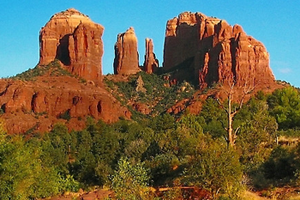
"Navigation is bedeviled by the fact that the earth's
magnetic field is riddled with local deviations and irregularities.
These faults have been very carefully plotted and the
most persistent of them have become quite notorious. One
of these lies off the Bahama Islands (the Bermuda Triangle),
another in the English county of Sussex, and a third near
Prescott in Arizona."
From THE ROMEO ERROR: A Matter of Life and Death
(1974), by Lyall Watson
Maybe I’m biased, being that I was born and raised in Phoenix, but I believe there is no state more amazing than Arizona. Virtually every type of climate and geology can be found here. Hot, punishing deserts and cool, mountain pine forests. Wide open grassy valleys, to tall mountain ranges. You can snow ski in the winter, water ski in the summer, or play golf, swim, hike, hunt, camp, or fish during the rest of the year. While people joke about “oceanfront property” in Arizona, we actually enjoy more coastline than any other state because of our many rivers and lakes, all of which are visited year-round. Houseboat vacationers on Lake Powell have over 2,000 miles of coastline alone to explore.
Madonna may assert that “everybody comes to Hollywood,” but I tend to believe that more actually come to visit, and stay here to live, than any other state, for every reason from climate to health reasons. We have bustling metropolises, welcoming suburbs, and sequestered rural towns. With the possible exception of Florida, more people retire here for at least half of the year. We lovingly refer to these folks as “snowbirds”. Phoenix and Scottsdale are famously known as “the valley of healing”, not only because of the drier, warmer weather, but also because of our famous medical facilities, such as the Mayo Clinic. While we are also the youngest state in the Union, barely 92 years young, we have an almost infamous history, thanks to the tales of the Wild West that still haunt towns like Tombstone.
But moreover, I don't think any other state has the natural beauty that is found here. We are of course the home of the Grand Canyon. But lest we forget, we are proud to claim the Painted Desert, Petrified Forest, the Mogollon Rim, San Francisco Peaks, Kartchner Caverns, and Superstition Mountains, just to name a few! But no list of awe-inspiring places in Arizona would be complete without mentioning Sedona.
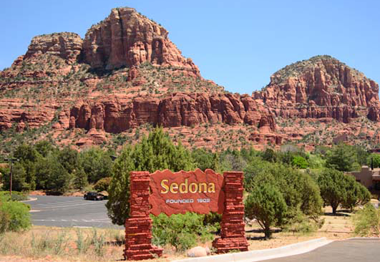 I visit Sedona as often
as I can. I have family that
lives in nearby Prescott, and I
used to make trips that would
follow Highway 89A from
Prescott through Jerome and
into Sedona, and then back to
Phoenix via I-17. I hiked there
and in the Verde Valley to the
south when I was about 10
years old. I have seen the
leaves change color in Oak
Creek Canyon and enjoyed the
natural "water slide" of Slide
Rock. I have respectfully visited
the ancient Sinagua Indian
ruins nearby. A mandatory stop
these days for me is
Tlaquepaque (pronounced Tala-
ka-pa-kee), a small artisan marketplace named and themed
after a Mexican village; more
than just a great place to see
and buy beautiful works of art,
I always feel drawn to the
chapel at the center. (It's a
secret desire of mine to perform
a wedding ceremony
there.)
I visit Sedona as often
as I can. I have family that
lives in nearby Prescott, and I
used to make trips that would
follow Highway 89A from
Prescott through Jerome and
into Sedona, and then back to
Phoenix via I-17. I hiked there
and in the Verde Valley to the
south when I was about 10
years old. I have seen the
leaves change color in Oak
Creek Canyon and enjoyed the
natural "water slide" of Slide
Rock. I have respectfully visited
the ancient Sinagua Indian
ruins nearby. A mandatory stop
these days for me is
Tlaquepaque (pronounced Tala-
ka-pa-kee), a small artisan marketplace named and themed
after a Mexican village; more
than just a great place to see
and buy beautiful works of art,
I always feel drawn to the
chapel at the center. (It's a
secret desire of mine to perform
a wedding ceremony
there.)
People around the world find themselves drawn to Sedona. When most people envision Arizona, they immediately either think of some Western they watched, or joke about it being a "dry heat" and getting lost among dunes and cacti. Most people discover Sedona when they come across a postcard or photograph which can only contain one of many amazing sites. When they hear about Sedona's majestic redrock mountains, spires, and canyons they demand to see it for themselves. For some, however, Sedona attracts people seeking a mystical or spiritual experience.
Sedona and the surrounding red rock country is considered to be a sacred place by the Yavapai Native Americans that still live in the area. One origin story of the Yavapai told by Mike Harrison and John Williams can be found in the 1978 book, The Yavapai of Fort McDowell by Sigrid Khera.
"We come out at Sedona,
the middle of the world.
This is our home… We call
Sedona Wipuk. We call it
after the rocks in the
mountains there. Some of
my people, they call themselves
Wipukpa. That's
the ones who live up there
around Sedona. All Yavapai
come from Sedona. But
in time they spread out."
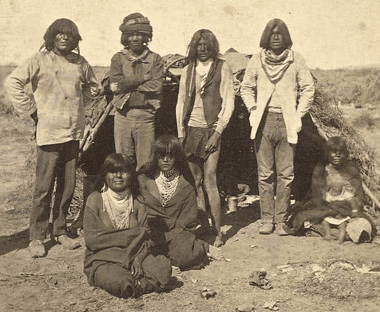
The Yavapai
A place of such natural beauty and native sacred significance is bound to lift your spirits. Some folks maintain there is a supernatural component to this inspiration. After 1987 when new age believers in Sedona participated in the Harmonic Convergence, the town seemed to be reborn. Psychics, holistic healers, and folks from all facets of the movement flocked to Sedona and discovered special areas of subtle energy fluctuations that have become known as Psychic Energy Vortexes, or simply vortexes.
Technically speaking, a vortex is the funnel shape created by the motion of spiraling energy through a medium, like a whirlpool. Vortices occur in nature as tornadoes, twisters, and other weather systems. Galaxies also take on the shape of a vortex.
Trying to describe the Sedona Vortexes with technical terms gets people in hot water, however. To be technical, there are no natural physical energy patterns that can be detected by scientific equipment, to the delight of the skeptics.
But even the skeptics who have visited the areas of the Vortexes cannot explain their own experiences. Like many spiritual and paranormal experiences, visits to the Vortexes require a certain amount of faith and open-mindedness.
In doing my own research into the phenomena, I find that the reason most people use technical terms to describe the phenomena is to compare it to something known in nature. Simply because a phenomena eludes our primary senses does not mean it does not act upon them.
As such, they adopted the term Vortex, and the lay plural Vortexes (versus the technical vortices), because they seem to be localized points of energy disturbances that radiate out from a center; strong at the core and weaker at the fringes.
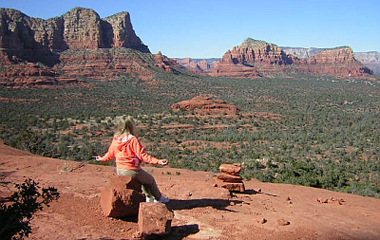 The spiraling nature of
the Vortexes is implied, but
some point to a curious natural
feature as evidence. Throughout
the area, there are many
groups of Juniper trees. In
some spots near the Vortexes
there are trees that are twisted
and warped. There is no natural
explanation for the random
yet localized twisted Junipers.
The spiraling nature of
the Vortexes is implied, but
some point to a curious natural
feature as evidence. Throughout
the area, there are many
groups of Juniper trees. In
some spots near the Vortexes
there are trees that are twisted
and warped. There is no natural
explanation for the random
yet localized twisted Junipers.
Another common misconception about the Vortex energy is that it is electromagnetic. Again, there is no evidence of EMF fluctuations in the area, nevertheless some claim that the iron oxide in the rock formations, which give them their red color, act to not only alter the magnetic fields in the area, but actually channel them.
Again, this is a case of misunderstanding the fact that the locals wanted to describe things in a technical manner for clarity's sake. They suggest that some Vortexes have an "electric" quality, or a male/masculine component to the surges. Others have a "magnetic" or female/feminine quality to them. Those that are harmoniously balanced are said to be "electro-magnetic", being a combination of the two. They try to avoid using the terms "positive", "negative", and "neutral" which have electric terminology relationships, but too often people equate these to mean "good", "bad", and "indifferent".
Thanks to the recent American fascination with Feng Shui and Chinese Geomancy, the popular terms of "yin" and "yang" have also been adopted. Personally, I actually prefer these terms, because a) they are not techno-babble that can mislead and imply scientific explanation, and b) they provide us with a familiar mystical image, which is represented as a swirling vortex of black and white emerging with equal strength from a center and swirling around to tapered tails, in perfect balance. A never-ending cycle that is more akin to the relationship of day and night.
In geomantic terms, yin refers to calm valleys and yang represents dramatic peaks. As it happens, Sedona is at a geological midpoint between the lush Verde Valley to the south and the mountains of Flagstaff to the north. This is an excellent balance of yin and yang.
Truly, what the Sedona Vortexes invoke then in people are experiences of spiritual awakening, emotional balance, and holistic healing. People come there seeking enlightenment, or even a powerful place for meditation and reflection. The potential visitor should expect however, because the Vortexes are such a popular destination, they can be busy or even downright crowded, especially when the tours are visiting.
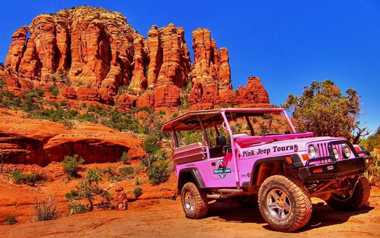 While on the subject, of
course there are dozens of tours
available. These vary from hiking
groups, to Jeep Tours to
more remote locations, to psychic
healing tours. As a friendly
word of warning, I won’t tell you
who to seek out to explore the
Vortexes – but the native
shamen neither give tours nor
do they "train" the locals. Caveat emptor.
While on the subject, of
course there are dozens of tours
available. These vary from hiking
groups, to Jeep Tours to
more remote locations, to psychic
healing tours. As a friendly
word of warning, I won’t tell you
who to seek out to explore the
Vortexes – but the native
shamen neither give tours nor
do they "train" the locals. Caveat emptor.
If you choose to bike and/or hike alone or with friends, there are many trails all over the area, and the ones leading to the Vortex sites are very well known. Many are easy enough even for novice hikers. Maps and books are available in various stores in town.
The book I recommend for those seeking to hike in and around Sedona, whether to hunt for the supernatural power of the Vortexes, or the awesome natural beauty of red rock country is SEDONA HIKES: 135 Day Hikes & 5 Vortex Sites Around Sedona, Arizona by Richard & Sherry Mangum. (ISBN 1-89151-703-1 $15.95)
Probably the most difficult aspect of the Vortex phenomenon is determining not only where they are, but how many there are. This is not only due to the experiences of visitors who may or may not notice anything different about them, but may be due to the very nature of the ebb and flow of the energies. It is quite possible they are not even static in their locations.
You may find rocks placed in large circles with a cross running through them. These are known as "Medicine Wheels", a symbol that gets its name from Native American traditions. Most hikers who have experienced a strong Vortex have made these giant markers to help their fellow seekers. However, as it is against the U.S. Forest Service rules to make these (disturbing the natural landscape), they are sometimes removed. Instead, it is best to trust your trail maps and your own senses. May you find what you are seeking, and enjoy what you discover.
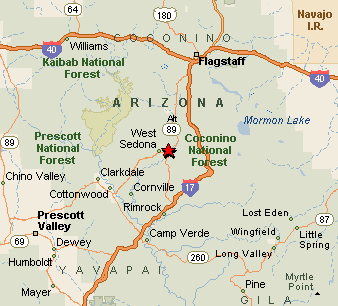 There are four wellknown,
commonly agreed upon
Vortex sites: Bell Rock, Airport
Mesa, Courthouse Butte (also
known as Cathedral Rock), and
finally Boynton Canyon. It may
not come as a surprise, from
my earlier discussion of the
Yavapai mythology of the area,
that Boynton Canyon is considered
to be the most powerful,
largest, and most balanced
of all four sites.
There are four wellknown,
commonly agreed upon
Vortex sites: Bell Rock, Airport
Mesa, Courthouse Butte (also
known as Cathedral Rock), and
finally Boynton Canyon. It may
not come as a surprise, from
my earlier discussion of the
Yavapai mythology of the area,
that Boynton Canyon is considered
to be the most powerful,
largest, and most balanced
of all four sites.
There are many other Vortexes, such as "The Cow Pies" and even the location of the Chapel of The Red Rocks. It is fair to say, I think, that the entire area is a giant power spot and if you find a place during your visit that gives you an unexpected energizing sensation that you just can’t dismiss as awe for the beauty around you, or deep appreciation of the nature, you can claim to have found another Vortex.
All roads may lead to Rome, but in Sedona, they all lead to the intersection of Highway 89A and 179, known affectionately as "The Y". The following directions to the main four Vortex sites all start from "The Y", the center of Sedona.
Highway 89A runs east to west through Sedona. East 89A takes you to Flagstaff. West 89A takes you to Cottonwood and Jerome. Highway 179 forms the southbound branch that meets with Interstate 17, taking you to the Verde Valley and eventually to Phoenix.
Bell Rock
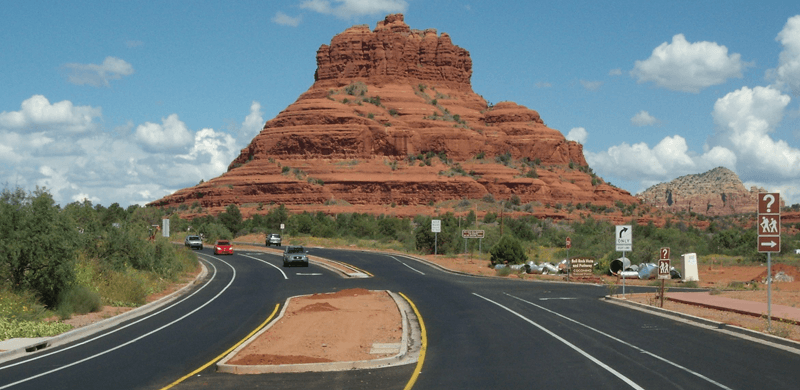
Take 179 south from the Y. Drive 5.1 miles. On your lefthand side is Bell Rock. This is perhaps the most famous, most photographed mountain in Sedona. It is therefore the busiest. Trails are readily available, easy to find, and fairly easy to take.
Airport Mesa
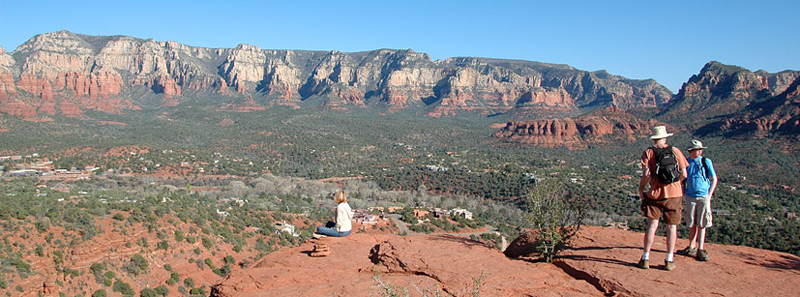
Take 89A west from the Y. Drive 1.1 miles and turn left at Airport Road. Take Airport Road .4 of a mile, on the right side is a sign that reads "Rainbow Ray Focus", and there is a pull-off on the right. The trail begins on your left, and a few rough trails lead from there to the hill. Over the hill, you will walk down to the Vortex area.
Boynton Canyon
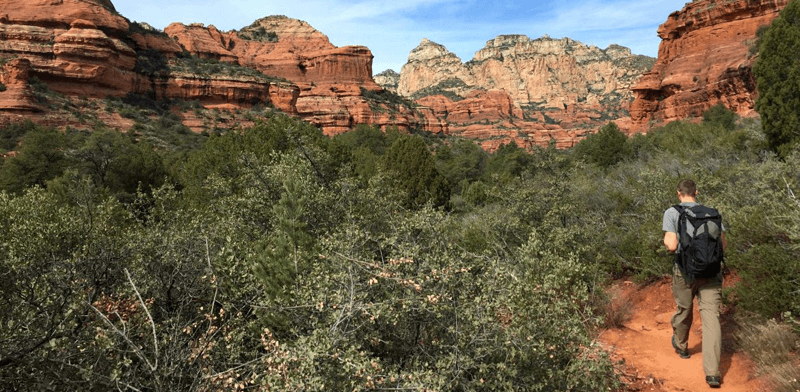
Take 89A west from the Y. Drive 3.2 miles and turn right at Dry Creek Road. Take Dry Creek road 2.9 miles, and turn left at the fork in the road, to another fork 1.6 miles later. Turn right at this fork, and continue to a firebreak road. Park here off the road, and walk down the firebreak road. This takes you to Boynton Canyon, home of one of the largest Vortexes. Most people find this area to be the most enchanting. Good name for a resort, eh?
Courthouse Butte / Cathedral Rock
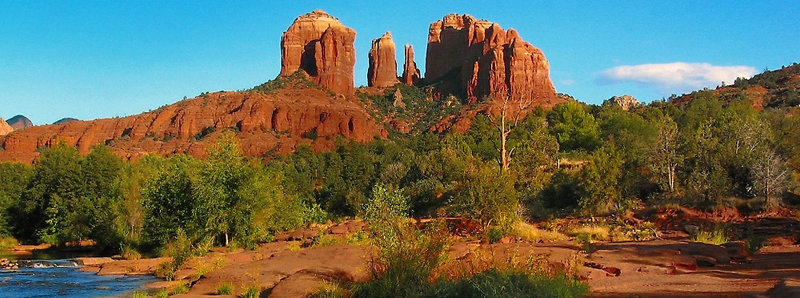
Take 179 south from the Y. Drive 7.2 miles, past the Village of Oak Creek, and turn right on Verde Valley School Road. Continue on for 3.2 more miles. Courthouse Rock is the formation to the right, and without a four-wheel drive vehicle, this is as close as you can get. The Vortex energy emanates in a 500-yard radius around Courthouse Rock. Trails are readily available.
Since the different Vortex sites have different qualities, they will affect different people in different ways. You do not have to be a psychic to experience their energies. You do not have to perform nor participate in elaborate ceremonies either, though they can be very helpful. The best advice is to visit them with an open mind and no expectations except to enjoy the beauty and splendor of an amazing place on earth. As it is only two hours drive north of Phoenix, and less than an hour from Flagstaff or Prescott, it is a worthwhile stop between all three cities.
Originally published in Acrimony Magazine Issue #10 June 2004



